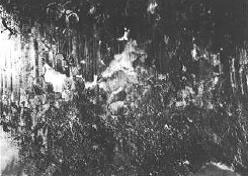Bearing Damage Index
Intergranular Craze Cracking
In high-speed turbomachinery bearings, the combination of high surface temperature and high shear rate can lead to the formation of a network of intergranular cracks in the hottest region of the bearing. Excessive lead content in tin-based babbitt can exacerbate this problem.
Addressing the Damage
Consult a bearing engineer regarding two possible solutions:
- Changing the bearing design to reduce the temperature or increase oil film thickness
- Changing to a bearing material with a higher strength and temperature limit
Depending on the cause of the overheating, tin-based babbitt could be replaced with aluminum-based alloys with higher temperature capability, and steel backing could be replaced with copper chromium (Cu/Cr) material to remove the heat more quickly. Replacement with a polymer lining could be appropriate if the main heat source is external to the bearing.

Figure 1: Whitemetal journal bearing from large steam turbine showing the typical ‘crumbly’ appearance of intergranular craze cracking

